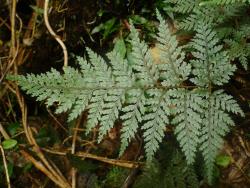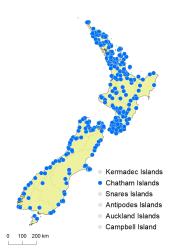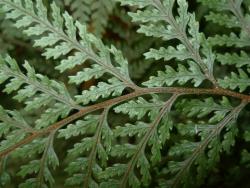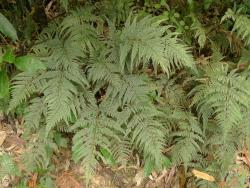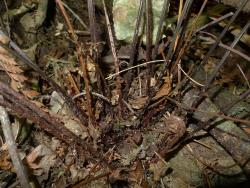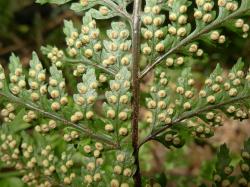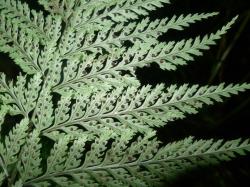- ≡ Nephrodium glabellum A.Cunn., Companion Bot. Mag. 2: 367 (1837)
- ≡ Lastrea glabella (A.Cunn.) Houlston & T.Moore, Gard. Mag. Bot. 3: 318 (1851)
- ≡ Nephrodium decompositum var. glabellum (A.Cunn.) Hook.f., Bot. Antarct. Voy. II (Fl. Nov.-Zel.) Part II, 39 (1854)
- ≡ Aspidium glabellum (A.Cunn.) E.J.Lowe, Ferns Brit. Exot. 6, 93, t. 32 (1857)
- ≡ Dryopteris glabella (A.Cunn.) C.Chr., Index Filic. 256 (1905)
- ≡ Ctenitis glabella (A.Cunn.) Copel., Gen. Fil. 124 (1947)
- ≡ Lastreopsis glabella (A.Cunn.) Tindale, Vict. Naturalist 73 (1957)
- = Nephrodium decompositum var. microphyllum Hook., Sp. Fil. 4, 146 (1862)
Rhizomes erect, up to 60 mm long (in herbarium material), densely scaly. Rhizome scales linear to narrowly ovate, 3.5–9 mm long, 0.4–1.0 mm wide, dark brown, margins entire or fimbriate. Fronds 120–900 mm long. Stipes 60–550 mm long, red-brown proximally, pale brown or pale purple-brown distally, scaly proximally, hairy or glabrous; scales narrowly ovate, brown or dark brown, 1–4.5 mm long, 0.2–0.4 mm wide, apices acuminate, margins entire; hairs red-brown, catenate (ctenitoid), up to 0.4 mm long. Rachises pale brown or pale purple-brown, sulcate, narrowly winged only at distal end, the sulcus densely filled with reddish catenate hairs up to 0.3 mm long, with slightly longer reddish hairs up to 0.4 mm long at costa/rachis junctions. Laminae 2-pinnate-pinnatifid to 3-pinnate-pinnatifid, ovate or broadly ovate, 60–400 mm long, 40–300 mm wide, dark green on both surfaces, herbaceous, glabrous or with scattered hairs abaxially, reddish catenate hairs up to 0.7 mm long on adaxial costae, and tiny yellow or orange clavate glands on abaxial lamina surfaces. Primary pinnae in 9–20 pairs below pinnatifid apex, slightly overlapping; distal pinnae narrowly ovate, proximal pinnae ovate or broadly ovate; the longest at or near the base, 25–205 mm long, 14–140 mm wide, apices acuminate, bases stalked; costae narrowly winged for most of their length except on largest fronds. Acroscopic secondary pinnae decreasing evenly in length along the primary pinnae to the distal end; the basal basiscopic secondary pinna the longest, ovate or narrowly ovate, 10–90 mm long, 3–35 mm wide, apices acute or acuminate, bases stalked, costae winged throughout. Tertiary segments oblong, 3–22 mm long, 1–7 mm wide, apices acute or obtuse and toothed, margins serrate to deeply divided, bases adnate or stalked. Sori round, medial; indusia reniform, 0.7–1.2 mm diameter, concolorous, yellow glands present or absent on the margins and surface.
Parapolystichum glabellum is characterised by its erect rhizome, 2–3-pinnate-pinnatifid laminae, reddish catenate hairs in the sulcus and on the adaxial costae, and only scattered hairs on the abaxial surface. It is distinguished from P. microsorum by its erect rather than creeping rhizome, and reddish hairs, which are largely confined to the adaxial surface, rather than whitish hairs, which occur on both surfaces. It is very similar to Parapolystichum kermadecense but generally has a more divided frond, shorter and narrower secondary pinnae (10–90 cf. 35–150 mm long, 3–35 cf. 11–45 mm wide), more abundant hairs, and more frequent and conspicuous glands.
North Island: Northland, Auckland, Volcanic Plateau, Gisborne, Taranaki, Southern North Island.
South Island: Western Nelson, Sounds-Nelson, Marlborough, Canterbury, Westland, Otago, Southland, Fiordland.
Chatham Islands, Stewart Island.
Altitudinal range: 0–760 m.
Parapolystichum glabellum occurs in lowland to montane areas throughout the North Island from Te Paki to Wellington, ranging from near sea level, up to 730 m at Blowhard Bush in the Kāweka Range. In the South Island it occurs in coastal and lowland areas throughout, but is absent from the drier inland regions and areas above c. 400 m. It reaches 760 m at Blue Duck Reserve, Marlborough. It also extends to Stewart Island and the Chatham Islands.
Parapolystichum glabellum occurs in wetter kauri, podocarp, broadleaved and beech forest, under mānuka and kānuka, in coastal forest, and rarely under Pinus and Cupressus macrocarpa. It is a terrestrial fern found on the forest floor, in damp gullies, on streambanks, river terraces, tracksides, bush margins, in boggy ground, and amongst rocks and boulders. It grows on greywacke, limestone and acidic volcanic substrates.
n = 82 (Brownlie 1958 – as Ctenitis glabella).



